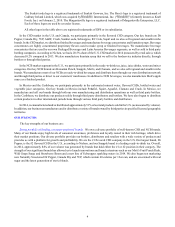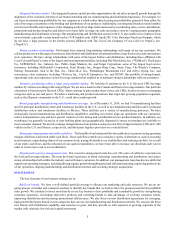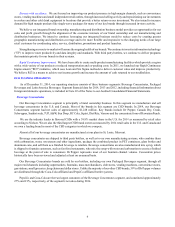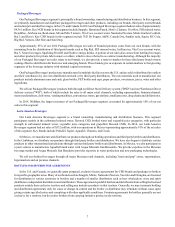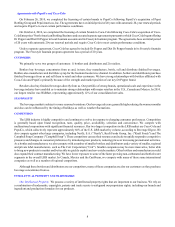Snapple 2014 Annual Report Download - page 17
Download and view the complete annual report
Please find page 17 of the 2014 Snapple annual report below. You can navigate through the pages in the report by either clicking on the pages listed below, or by using the keyword search tool below to find specific information within the annual report.
14
Increases in our cost of benefits and multi-employer plan withdrawal liabilities in the future could reduce our profitability.
Our profitability is substantially affected by costs for employee health care, pension and other retirement programs and other
benefits. In recent years, these costs have increased significantly due to factors such as increases in health care costs, declines in
investment returns on pension assets and changes in discount rates used to calculate pension and related liabilities. These factors
plus the enactment of the Patient Protection and Affordable Care Act in March 2010 will continue to put pressure on our business
and financial performance. Although we actively seek to control increases in costs, there can be no assurance that we will succeed
in limiting future cost increases, and continued upward pressure in costs could have a material adverse effect on our business and
financial performance.
Additionally, we currently participate in three multi-employer pension plans in the United States. The plans we participate in
have collective bargaining agreements, which will expire at various dates through 2016. In the event that it becomes probable that
we intend to withdraw from participation in any of these plans, U.S. GAAP would require us to record a withdrawal liability if it
is estimable, which may be material and could negatively impact our financial performance in the applicable periods. Our pension
expense for U.S. multi-employer plans totaled $6 million for the year ended December 31, 2014.
Costs for commodities, such as raw materials and energy, may change substantially.
The principal raw materials we use in our products are aluminum cans and ends, glass bottles, PET bottles and caps, paperboard
packaging, sweeteners, juice, fruit, water and other ingredients. The cost of such raw materials can fluctuate substantially. Under
many of our supply arrangements, the price we pay for raw materials fluctuates along with certain changes in underlying
commodities costs, such as aluminum in the case of cans, natural gas in the case of glass bottles, resin in the case of PET bottles
and caps, corn in the case of sweeteners and pulp in the case of paperboard packaging.
In addition, we use a significant amount of energy in our business. We are significantly impacted by changes in fuel costs due
to the large truck fleet we operate in our distribution businesses and our use of third party carriers. Additionally, conversion of
raw materials into our products for sale uses electricity and natural gas.
Price increases could exert pressure on our costs and we may not be able to effectively hedge or pass along any such increases
to our customers or consumers. Price increases we pass along to our customers or consumers could reduce demand for our products.
Such increases could negatively affect our business and financial performance. Furthermore, price decreases in commodities that
we have effectively hedged could also increase our cost of goods sold for mark-to-market changes in the derivative instruments.
Fluctuations in foreign currency exchange rates in Mexico and Canada may adversely affect our operating results.
We are exposed to foreign currency exchange rate risk with respect to our sales, expenses, profits, assets and liabilities
denominated in the Mexican peso or the Canadian dollar. We manage a small portion of our exposure to the Canadian dollar
utilizing derivative instruments and are not protected against most foreign currency fluctuations. As a result, our financial
performance may be affected by changes in foreign currency exchange rates. Moreover, any favorable or unfavorable impacts
to gross profit, gross margin, income from operations or segment operating profit from fluctuations in foreign currency
exchange rates are likely to be unsustainable over time.
Our financial results may be negatively impacted by recession, financial and credit market disruptions and other economic
conditions.
Changes in economic and financial conditions in the U.S., Canada, Mexico or the Caribbean may negatively impact consumer
confidence and consumer spending, which could result in a reduction in our sales volume and/or switching to lower price offerings.
Similarly, disruptions in financial and credit markets worldwide may impact our ability to manage normal commercial relationships
with our customers, suppliers and creditors. These disruptions could have a negative impact on the ability of our customers to
timely pay their obligations to us, thus reducing our cash flow, or the ability of our vendors to timely supply materials. Additionally,
these disruptions could have a negative effect on our ability to raise capital through the issuance of unsecured commercial paper
or senior notes.
We could also face increased counterparty risk for our cash investments and our hedging arrangements. Declines in the
securities and credit markets could also affect our marketable securities and pension fund, which in turn could increase funding
requirements.


